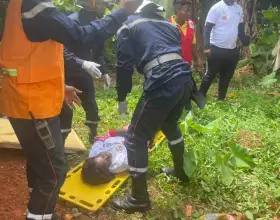
A new study on the evolution, sphere of influence, and general operations of terrorists locally known as ‘bandits’, in Northwest Nigeria has provided a list of the major gangs operating in the region, as well as historical background to their formation in the region.
Dr Murtala Ahmed Rufa’i of Usmanu Danfodiyo University, Sokoto, who presented the research at the 15th University Seminar, described his work as a “decade of research on armed banditry in Zamfara State,” which is the terrorists’ main operational theatre.
The researcher said he compiled the terrorists’ list and the estimated number of their gang members, operations, and sphere of influence through various field works to gain a better understanding of the terrorists.
Rufa’i traced the origins of terrorism in the region to the first criminal gang organised by now killed terrorists known as Kundu and Buharin Daji, who migrated from Katsina and stationed themselves in a village near the Zamfara-Katsina border, where they formed a group of cattle rustlers known locally as “Kungiyar Barayin Shanu” – Group of Cattle Rustlers.
“It grew from a single cell, mainly in operation in Zamfara in 2011, to over one hundred and twenty (120) gangs across six states in 2021,” he said.
According to the research, the terrorists who named themselves “Kungiyar Gayu” – a Group of Youth – operated in the woods, but the true motivation became clear in 2012, when cases of cattle rustling began to emerge in some parts of Zamfara state.
He revealed that members of the gang saw the group as a cultural organisation dedicated to liberating ‘Fulani’ people from the oppression of security agents, traditional rulers, and politicians who accused them of extortion and confiscation.
“Initially, its members were Fulani; creating room for ethnic profiling and the criminalisation of the Fulanis as cattle rustlers in the state. Such ethnic profiling was responsible for forcing many herders into the gang,” the study revealed.
According to the research, conscription through the use of money and cows, the promise of sex and leisure, and intimidation of other Fulani people were all used to recruit members. Some herders also joined the gang to avoid being harassed by the members for cattle rustling.
The research has also estimated the number of terrorists operating in Zamfara alone to be about 10,000 persons who “have so far killed over 12,000 people and stolen about 250,000 livestock from 2011 to 2021.”
“About 120 villages were destroyed while 50,000 people were either internally displaced or made refugees in the neighbouring Niger Republic.”
The research mentioned that in recent years, the conflict has made some gang leaders extremely rich through the illegal trade of arms and banditry. The terrorists frequently make multiple profits from the sale and use of weapons, sale of cattle, which are usually stolen from the people and exchanged for weapons.
According to the research, terrorists divided different parts of Northwest and North-central into “bandits camps,” with terrorists such as Dogo Gide operating in Kaduna and Niger states, Yellow Jan-bros in Birnin Gwari and Giwa areas of Kaduna State, Tsoho Manjagara in some parts of Giwa, Alhaji Bodere and Alhaji Beleri in Sabon Birni of Kaduna State, Yellow Ashana in Sabon Garin Gyadam of Kaduna state.
Others include Alhaji Isiya, Buhari General, and Gannaei operating along the Abuja-Kaduna Highway, Alhaji Ado Alero in Yankuzo, Katsina State, and some parts of Zamfara State, Alhaji Auta Ardo in Birnin Magaji, Zamfara State, Lanke and Umar Bango in Dan-Rumfa village, Katsina, Dangote Bazamfare in Zamfara.
The study revealed that increased availability of illicit weapons in Nigeria is one of the factors aiding the growth in the number of terrorists in the region.
“In 2005, an estimated four million illicit arms were circulating in West Africa, out of which 1.5 million could be found in Nigeria. However, as of 2021, the number, ownership, use and sophistication of these weapons have tripled the 2005 figures,” the research mentioned.
Gender dimensions
The study added a gender dimension to the terrorist operation in the Northwest by describing the involvement of married women and teenage girls, which it said “complicates matters.”
“Besides providing intelligence, they as well served as cooks and guards to the abductees either in the kidnapping den or ruga.”
The girls also take part in attacks against an opposing gang or a stubborn village, the research stated, adding, “they also participate in long-distance attacks as residents of Sabon Birni and Isa in Sokoto State had reported seeing women among the attackers.”
“Like any other member of the gang, women also received their own fair share in every successful attack, in cash and cattle as proceeds or ‘booties of war’. Also, bandits’ wives keep and service the guns before or after operations,” the research found.
Support Our Journalism
There are millions of ordinary people affected by conflict in Africa whose stories are missing in the mainstream media. HumAngle is determined to tell those challenging and under-reported stories, hoping that the people impacted by these conflicts will find the safety and security they deserve.
To ensure that we continue to provide public service coverage, we have a small favour to ask you. We want you to be part of our journalistic endeavour by contributing a token to us.
Your donation will further promote a robust, free, and independent media.
Donate HereStay Closer To The Stories That Matter




